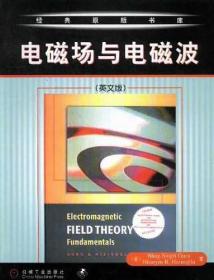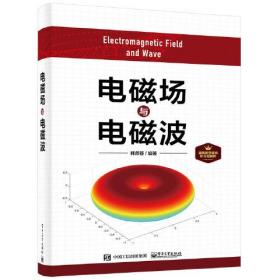
电磁场与电磁波 外语-英语读物 张育 等
none
¥ 25.95 5.8折 ¥ 45 全新
仅1件
北京丰台
认证卖家担保交易快速发货售后保障
作者张育 等
出版社中山大学出版社
ISBN9787306045355
出版时间2013-06
版次1
装帧平装
开本16
页数312页
字数588千字
定价45元
货号xhwx_1200760309
上书时间2024-10-30
- 在售商品 暂无
- 平均发货时间 27小时
- 好评率 暂无
- 最新上架
商品详情
- 品相描述:全新
- 正版特价新书
- 商品描述
-
主编:
电磁场与电磁波(英文)共分为9章,即矢量分析、静电场、静电场的特殊解法、恒定电流场、恒定磁场、时变电磁场、面电磁波、导行电磁波及天线。每章均配有难度适当、基本覆盖本章内容的题,大部分章节配有相应的思题。电磁场与电磁波(英文)可作为电子信息类专业本科生一学期课程的教材和参用书,也可作为物理专业本科生和工程技术人员的参用书。
目录:
chapter 1 vector analysis
1.1 introduction
1.2 vectors operation
1.vector addition and subtraction
2.multiplication of vector by a scalar
3.scalar product
4.vector product
5.product of three vectors
1.3 coordinate systems
1.curvilinear orthogonal coordinates
2.rectangular coordinate systems
3.cylindrical coordinate systems
4.spherical coordinate systems
1.4 scalar and vector fields
1.5 directional derivative and gradient
1.6 divergence of a vector field
1.7 curl of a vector field
1.8 lacian operator
1.9 del operator operation
1.10 dirac delta-function
1.11 some theorems
1.greens theorem
2.uniqueness theorem
3.helmhohzs theorem
problems
chapter 2 electrostatic fields
2.1 introduction
2.2 coulombs law
1.charge
2.electrostatic force
2.3 electric field intensity
2.4 electric field lines
2.5 equations for electrostatic fields
1.basic equations
2.electrostatic potential
3.poissons and laces equations
2.6 electric fields in materials
1.materials in electric field
2.polarization of dielectrics
3.the field equations in dielectrics
2.7 boundary conditions
1.normal ponents
2.tangential ponents
2.8 capacitances
2.9 energy and forces
1.energy of the electric field
2.electric force
2.10 muhipole expansion
problems
chapter 3 spe methods in electrostatics
3.1 introduction
3.2 uniqueness theorem for electrostatics
3.3 method of images
3.4 method of separation of variables
1.method of separation of variables in rectangular coordinates
2.separation of variables in cylindrical coordinates
3.separation of variables in spherical coordinates
problems
chapter 4 steady electric current fields
4.1 introduction
4.2 current
1.conduction current
2.convection current
4.3 resistance of a conductor
4.4 the equation of continuity
4.5 relaxation time
4.6 joules law
4.7 boundary conditions for steady current density
problems
chapter 5 steady magic fields
5.1 introduction
5.2 biot-savarts law
5.3 ampbres force law
5.4 basic equations for steady magic fields
5.5 magic vector potential
5.6 magization of media
1.magic materials
2.describing of magization
3.magic field in media
5.7 boundary conditions for magic fields
5.8 magic scalar potential
1.magic scalar potential differential equation
2.boundary conditions for magic scalar potential
5.9 energy in a magic field
5.10 expansion of the magic vector potential
problems
chapter 6 time.varying electromagic fields
6.1 introduction
6.2 faradays law of induction
6.3 maxwells equation (faradays law)
6.4 discement electric current
6.5 maxwells equations and boundary conditions
1.maxwells equations
2.boundary conditions
6.6 lorentz force density equation
6.7 poyntings theorem
6.8 time-harmonic fields
6.9 inductances
1.self-inductance
2.mutual inductance
6.10 energy in steady magic fields
problems
chapter 7 ne wave propagation
7.1 introduction
7.2 general wave equation
7.3 ne wave in a dielectric medium
7.4 ne wave in a conducting medium
7.5 ne wave in a good conductor
7.6 ne wave in a good dielectric
7.7 polarization of a wave
1.a linearly polarized wave
2.a circularly polarized wave
3.an elliptically polarized wave
7.8 normal incidence of ne waves
1.conductor-conductor interface
2.dielectric-dielectric interface
3.dielectric-perfect conductor interface
4.dielectric-conductor interface
7.9 oblique incidence of ne waves in lossless media
1.polarization of e perpendicular to the ne of incidence
2.polarization of e parallel to the ne of incidence
3.total and null reflections
7.10 oblique incidence of ne waves in lossy media
7.11 group velocity
problems
chapter 8 guided electromagic waves
8.1 introduction
8.2 the boundary conditions due to perfect conductor
8.3 rectangular waveguide
1.distributions of fields
2.cutoff frequency
3.phase velocity and group velocity
4.waveguide impedance
5.te10 wave in rectangular waveguides
6.losses in a waveguide
8.4 cavity resonators
8.5 transmission line
1.parameters of transmission line
2.kirchhoffs laws
3.transmission line equations
4.propagation constant
5.characteristic impedance
6.reflection coefficient
7.input impedance
8.expressions of voltage and current
8.6 wave guide of arbitrary shape
1.tm modes
2.te modes
3.tem modes
8.7 the tem mode of a coaal cable
problems
chapter 9 antennas
9.1 introduction
9.2 the vector and scalar potentials of electromagic fields
9.3 wave equations in terms of potential functions
9.4 retarded potentials
9.5 hertzian dipole
1.radiation fields
2.directivity of the antenna
3.radiation power
4.radiation resistance
5.directive gain
9.6 a magic dipole
9.7 a short-dipole antenna
9.8 a half-wave dipole antenna
9.9 antenna arrays
9.10 reciprocity theorem
problems
references
appendixes
a.physical constants
b.vector formulas
1.vector operation
2.differential operation
3.integral transform
4.greens theorem
c.orthogonal coordinate systems
1.transform of coordinate ponents
2.differential operations
d.electromagic spectrum
内容简介:
电磁场与电磁波是为普通高等学校电子信息类专业“电磁场理论”基础课所编写的本科双语教材,注重于系统的基础理论推演与实际应用相结台,难度符合靠前该课程要求:全书共分为9章,内容包括矢量分析、静电场、静电场的特殊解法、恒定电流场、恒定磁场、时变电磁场、面电磁波、导行电磁波及天线。电磁场与电磁波可作为电子信息类专业本科生一学期课程的教材和参用书,也可作为物理专业本科生和工程技术人员的参用书。本书由张育、王磊等编著。
相关推荐
— 没有更多了 —

























以下为对购买帮助不大的评价